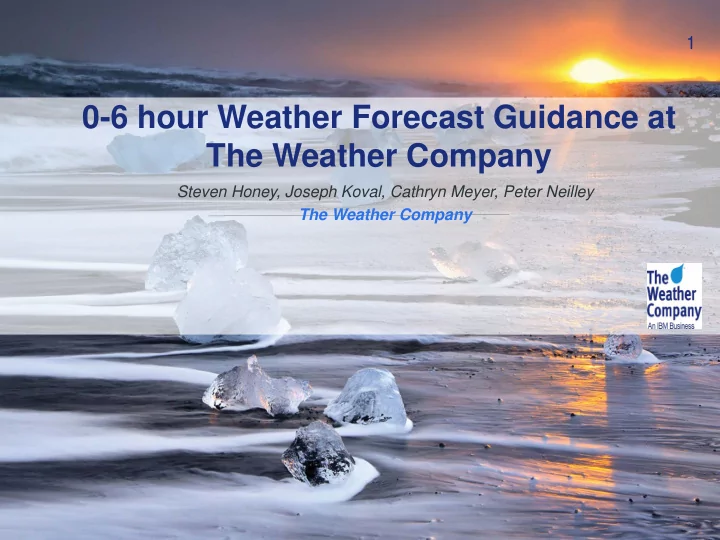

1 0-6 hour Weather Forecast Guidance at The Weather Company Steven Honey, Joseph Koval, Cathryn Meyer, Peter Neilley The Weather Company
2 TWC Forecasts: Widespread Adoption
3 0-6 Hour Forecast Details • Global coverage • 15-minute precision for forecasts of: • Precipitation: Type, Accumulation and Probability • Temperature • Cloud Cover • Government Warning Information • Forecasts updated every 5 min using latest radar and NWP data • Alerting capability for start of precipitation and Warnings
4 How are 0-6 hr forecasts built? Integrate radar Manual QC data into mosaic 5m Mosaics Automated QC + Time Synchronization Vectors Motion 0-7 hr Radar Forecast POP QPE HOTL Blend TOR/SVR Public Forecast Forward Err. Correction of Update and Alerts T, Td, Wind Global + T, Td, vis, Regional NWP mslp, rh Fcster edits 1-15 day multi-model ensemble blend
5 Radar Processing: TWC Global Coverage
6 Radar Processing: TWC NOWRad Coverage
7 Radar Processing: Extrapolation • Radar extrapolated out to 7 hours • Radar motion detected by tracking cells in subsequent radar mosaics • Extrapolation forward in time using a backward semi-lagrangian advection scheme
8 Deep Thunder: TWC Numerical Weather Prediction • 13km Global, 6-hour updates • 4km Regional with 3 and 1-hour updates
9 Radar + NWP Blending • Temporal Blend of radar extrapolated and NWP forecasts with weight as a f (forecast time, prob thunder) • Assumption is that precipitation motion and initiation is more linear when non-convective Radar -> NWP Radar -> NWP High Prob Low Prob Thunder Thunder Fcst time (0->360min) Fcst time (0->360min) • Currently working to incorporate more advanced blending algorithms
10 Probability of Precipitation • POP is critical to TWC Consumer Forecasts: • 30-39%: “Isolated Showers” • 40-59%: “Scattered Showers” • >60%: “Rain” • How do we get probability from deterministic nowcasts?
11 Probability of Precipitation: Radar Extrapolation • Intensity-weighted spatial analysis at each grid point Example: 20 km box on 4km grid = Coverage * Weighted Intensity = 0.80 * 325 / 500 = 52% POP • Analysis box increases from 12 km to 40 km between 0 and 2 hours, then remains constant to 7 hours 2 hr: 79% 0 hr: 100% 1 hr: 91%
12 Probability of Precip: NWP Time Lagged Ensemble 1. Spatial POP calculated for all NWP forecasts using a 40km box 2. Weighted average of spatial POP from all forecasts with lead time <= 8 hours 3. Calculated every 15 min between now and 9 hours from now Weights for recent runs 4:2 4:2 4:4:3:3:2:2:2 4:3:2
13 Probability of Precip: NWP Time Lagged Ensemble Contour: POP Shaded: Blended radar + model precipitation rate forecast Spatial Only Spatial + TLE
14 Probability of Precipitation: Blend • Temporally blend the Radar extrapolated POP and the NWP (time-lagged ensemble) POP, in same way that precipitation rate is blended Radar -> NWP Radar -> NWP High Prob Low Prob Thunder Thunder Fcst time (0->360min) Fcst time (0->360min)
15 Putting it all together Deterministic precipitation accumulation (shaded) Probabilistic Occurrence (contour) Forecast Public Forecast Observed hr Acc(mm) POP Worded Forecast 0 0 15 Cloudy 1 1 36 Scattered Strong Storms 2 4 47 Scattered Strong Storms 3 5 64 Strong Storms 4 1 71 Thunderstorms 5 2 58 Scattered Thunderstorms POP KNYC 6 4 40 Scattered Thunderstorms
16 Radar + NWP: 6-hour Precipitation Forecasts
17 Government Issued Warnings • TOR/SVR Warning “promote” textual forecasts • NOWCAST Without Warning: • “Expect occasional thunderstorms to end at 3:30pm.” • NOWCAST When SVR Warning is issued: • “Showers and thunderstorms ending around 3:30pm. Some of the storms could be severe.”
18 Looking ahead • Acquire more radar data to expand radar coverage • We will use other sources (satellite, lightning) to enhance initial precipitation analysis • Parameters will become dynamic • Temporal blending weights • Spatial analysis size • Time-lagged ensemble weightings • Alternative methods for deriving POP from radar extrapolation • Spatial phase correction applied to model • Intensity correction applied to model
19 Looking Ahead 10 days ending 23 July 2016 United States Domain 0.05”/hr, 1.27 mm/hr Operational Radar Extrap Operational NWP Research: Laterally Corrected Blended Courtesy James Pinto, NCAR
Recommend
More recommend